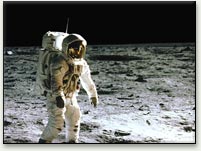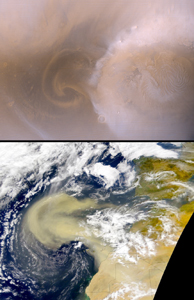A page from the "Causes of Color" exhibit...
What color is the Martian sky?


Variety of daytime skies. The moon’s sky is black because it has no atmosphere. The earth normally has a blue or a gray sky, depending on cloud cover. On earth, windstorms sometimes swirl dust into the air, making the sky a hazy tan. Similarly, Mars’ atmosphere always contains a lot of dust, and its sky is permanently tan.
Mars may not be made of green cheese, but its sky looks like butterscotch....
What about the Martian sky?
On Mars, photographs from landing vehicles (the Viking from 1976-78 and the Pathfinder in 1997) suggested that the sky is generally a butterscotch (yellowish-brown) color. Mars appears to have a permanent haze of dust, which remains suspended in the air after dust storms. The dust contains the mineral limonite, a brown iron oxide found on most of the Martian surface. Sky color measurements from Viking Lander 1 have been used with computer simulations of light scattering to estimate that the dust particles contained about 1% by volume of another iron oxide mineral known as magnetite (a black, opaque material).
The sky is not blue as on Earth because Martian air is extremely thin, and the dust particles in the air are large relative to the wavelength of visible light. The dust particles preferentially absorb blue light and effectively act as mirrors by scattering the remaining wavelengths: this produces the butterscotch color of the atmosphere.
We know the color of the Martian daytime sky from properly color-balanced pictures taken by the Viking landers in 1976 and Mars Pathfinder in 1997. The first Viking lander images broadcast over TV in the 1970s showed a blue sky, later "corrected" to a pink sky. In addition to uncertainties in the initial image processing, the lander had several color patches to calibrate the cameras, which were partially covered with Martian dust thrown up during landing. However, further analysis of Viking lander data revealed a Martian sky that is generally butterscotch in color, except for the pink or red of sunset and sunrise. In 1997, the Mars Pathfinder confirmed this finding.
Dust storm on Mars, 29 August 2000, taken near the north pole by the Mars Orbiter Camera. The storm measures about 900 km across; such storms have been known to engulf most of the planet.
Measurements taken by the two Viking lander spacecraft demonstrated that the Martian atmosphere always had some fine dust suspended in it. The dust particles vary in size, from smaller than visible light wavelengths (which range from approximately 0.4 to 0.7 µm) to as large as several tens of µm. Therefore, scattering (including absorption) of sunlight by the dust particles in the Martian atmosphere accounts for the sky’s color.
Because the dust particles both absorb and reflect sunlight, and because large particles lead to more uniform scattering among different wavelengths, Rayleigh scattering cannot completely explain the sky’s color. If the dust did not absorb any sunlight, the Martian sky would appear whitish, since all wavelengths would be scattered equally, just as clouds scatter sunlight. The atmospheric dust that provides the butterscotch tint to the Martian sky also produces the characteristic red color of Mars seen by the naked eye.
While Rayleigh scattering has a very small effect in the Martian atmosphere, at certain times and in certain places, clouds of extremely small dust particles give a blue cast to images taken from overhead. These are the so-called "blue hazes" observed in some cratered regions and parts of the Valles Marineris.
If the Martian atmosphere were free of dust, the daytime sky would appear blue, because of Rayleigh scattering by the molecules (primarily carbon dioxide) that make up the atmosphere. Because the atmosphere is thinner than earth’s atmosphere, the Martian sky would be a darker blue than ours, much as the sky on earth appears at high altitudes with a similar density of air molecules. It is possible (though unlikely) that future missions to Mars will find a different sky color.




